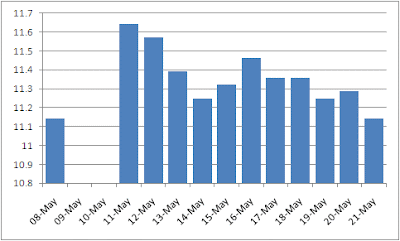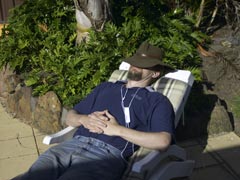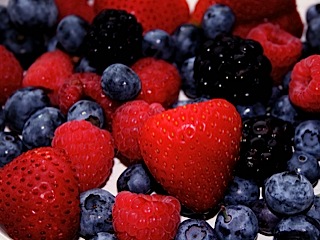
I received the results of my Vitamin D test this week. I have a level of 29 ng/mL. The healthy level, according to
Grassroots Health, the organisation who did the test, is 40-60 ng/mL.
Others say 50-80 ng/mL.
Either way, this makes me significantly deficient. When you consider the effort I had been making to in the months leading up to the test, this is a salutary lesson to anyone living in a climate similar to the UK or who avoids the sun.
If you look at the
top food sources of vitamin D, you'll see Liver, Beef, Salmon, Herring
, Mackerel, Sardines and Eggs amongst the few rich dietary sources.
If you follow my meal updates on Twitter you'll know just how much of these foods I eat on a weekly basis. I would estimate 1-3 tins of wild salmon, 6-10 tins of sardines, 1-2 whole mackerel, 1-2 whole herring and 20-30 organic eggs. Liver and beef are also regulars.
Not only that, but in the 2 weeks leading up to the test I had spent 3 or 4 lunchtimes sunbathing in a field near my office in just my underwear, at no small cost, I might add, to my already shaky status as a sane employee.
When I started reading about Vitamin D I could tell it was important - but it seemed complicated. So for the benefit of those of you who are in the same position, here are the basics, along with references to other bloggers and Web sites where I found the information.
Vitamin D is a fat-soluble vitamin. This means the body stores it. Good, because it means we can build up reserves; bad, because if we have too much, there is the possibility of toxicity. Other vitamins, like vitamin C, are water soluble and not stored. Good, because less toxicity risk; bad, because daily consumption is necessary for good health.
There are two forms of vitamin D. These are D2 and D3. This confused me. But all you really need to know is that both of them are vitamin D.
You can get vitamin D from the sun. The D3 form is produced in the body when sunlight falls on your skin. This process is thought to be self-regulating so that it is not possible to cause vitamin D toxicity from sun exposure (I read that here.)
You can get vitamin D from food. Various foods contain vitamin D2 - this page lists some. I can tell you it must be pretty hard to reach toxic levels through D-rich foods, based on my own experience. I practically turned into a sardine one week, yet, as we have seen, turned out to be deficient.
You can get vitamin D from supplements. Apparently the type to go for is vitamin D3. Not sure why this is the best form to use, but apparently it is (I read it on Free the Animal). You CAN reach toxic levels through supplementation.
You can get tested for vitamin D levels. I read on the Vitamin D Council website that the correct test to get is what's called the 25-hydroxy vitamin D test, or 25-OH Vitamin D test. Your doctor may authorise it and medical insurance might cover it - but I took neither route. I sent off for a test with Grassroots Health having seen them recommended in this Life Spotlight article. It cost about $30 / £20.
Vitamin D levels may affect athletic performance, which I also read on the Vitamin D Council website, here.
Vitamin D deficiency is linked to a number of illnesses. I am not sure where to start with this one - here are a few: multiple sclerosis, cancer, depression, autism. Put, another way, a number of conditions have been found to respond well to vitamin D supplementation. To find out more, do some Googling - there is a wealth of information about vitamin D and various conditions. Or you could start with the various posts on the topic from Free the Animal, here.
The theory is that even in a climate like the UK we would have been exposed to a lot of sun when we were hunter gatherers. We would have spent most of the time outside. Stored reserves from the spring, summer and autumn and a diet rich in meat, fish and eggs, would have got us through the winter.
But now, most of us spend most days, even in summer, in the office or some other indoor venue; and even those who do spend time outdoors tend to avoid the sun or use suncream for fear of cancer.
I don't want to go into the cancer from sun exposure vs. cancer from vitamin D deficiency issue here. If you want a great summary of why it might not be an issue provided you follow certain rules, read Mike and Mary Eades' Protein Power Life Plan. There's also a good post on the subject on Free the Animal.
This is the plan I am following:
- Get tested and find out your level.
- If deficient, take steps to get your level in the healthy range. This might be getting more sun, supplementing, or a combination of both.
- Get tested again.
- Adjust your regime if necessary, otherwise, just carry on as you are.
- Keep getting tested just in case.
Grassroots Health gave me some guidelines. They said that taking 1000 ui of vitamin D3 per day would raise the levels in my body by 10 ng/mL.
How much you can raise the levels with sun are much more complicated and they offered no advice. It depends on so many factors - time of year, pollution, proximity to the equator, skin colour. So I figure you just have to play this one by ear - and it is one good reason to get regularly tested.
So I am now on step 2. I have some 1000 iu D3 supplements on their way. I will take 3 per day. This should take my levels up to 59. Since it is the summer in the UK, I will be also be getting more sun. So it's possible I will go higher - but since up to 80 is seen as healthy, I feel I have a safety zone. My planned retest in October will tell me whether the amount of sun I got meant I did not need 3000 iu per day.
- Better performance with my training.
- Any changes to general well-being
- A change in my neutrophil count - in an unrelated matter, I have been having blood tests to monitor this and other readings. If you are interested, see my conversation with Dave in the comments on this post. By coincidence I have just had another of these other tests (there was no change,) so I have a pre-supplementation baseline level.
If you do decide to get tested, I can certainly vouch for Grassroots Health. They sent the kit overseas to the UK promptly, and even sent me a second one when I complained that the first one didn't work - even though it was probably my own fault. You are supposed to wash your hands in hot water to ensure blood flow. My water was only warm. The second test worked fine.
I should add that the 'pre-paid' envelope they provided for returning the sample was not suitable for use outside the USA - so non-US folk like me need to add an airmail sticker and additional postage.
See Also:
My Wheat Experiment
My Wheat Experiment Blood Test Update
How I Got My Vitamin D into the Sweet Spot
... Read more
 One of the advantages of twittering your meals, blogging your workouts and obsessively recording your weight is that you can backtrack through a period of time and see exactly what you were doing and how it affected your weight.
One of the advantages of twittering your meals, blogging your workouts and obsessively recording your weight is that you can backtrack through a period of time and see exactly what you were doing and how it affected your weight.

















